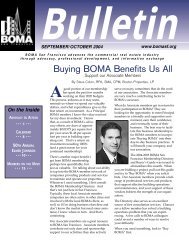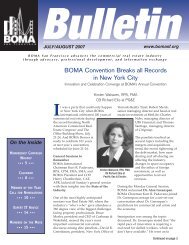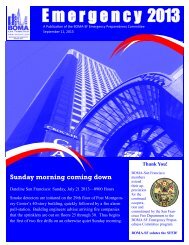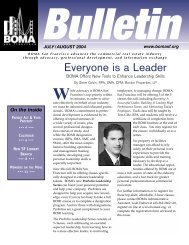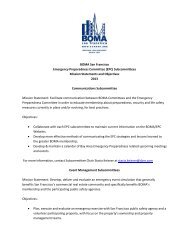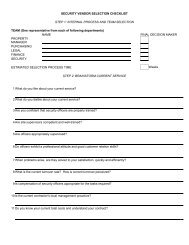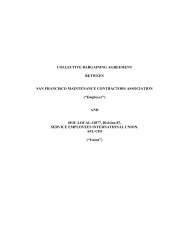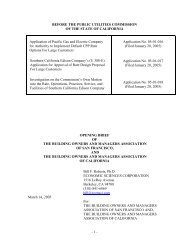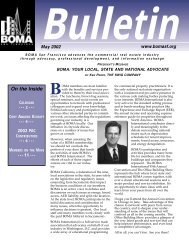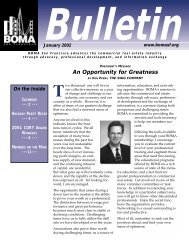Superstorm Sandy Lessons Learned - BOMA SF
Superstorm Sandy Lessons Learned - BOMA SF
Superstorm Sandy Lessons Learned - BOMA SF
Create successful ePaper yourself
Turn your PDF publications into a flip-book with our unique Google optimized e-Paper software.
Consider establishing a social media account (such as Twitter) and have tenants and vendors subscribe to it.<br />
This is an easy way to provide current information to tenants and vendors, regardless of whether or not email,<br />
phone or computers are available.<br />
Disaster Planning and Preparation<br />
The survey indicated that 62% of the buildings had a recovery/continuity plan at the time of the storm; 35% of those<br />
that had a plan activated the plan. The plans covered a myriad of areas (such as IT disaster recovery, supplies,<br />
staffing), and 53% of the buildings had plans which had planned for disruptions exceeding one week.<br />
Once it became clear that Hurricane <strong>Sandy</strong> would be a major event, many conducted pre-incident planning meetings<br />
with critical vendors, tenants and building staff. Critical building systems were tested and many buildings ordered<br />
additional supplies. According to the survey, most received requested supplies and equipment prior to the storm.<br />
There was significant feedback underscoring the importance of understanding the different types of plans. Some<br />
respondents referred to activating their Emergency Action Plan (EAP), per New York City rules. While an EAP is<br />
adequate for immediate response and may be implemented in such instances (e.g. the crane incident on 57 th Street),<br />
the EAP is not designed to address building preparedness, recovery and restoration processes.<br />
Finally, owner/manager survey respondents who did not have a disaster recovery/business continuity plan in place<br />
prior to the storm said that they would consider developing a post-incident continuity/recovery plan.<br />
Recommendations<br />
Understand the difference between emergency response (i.e. EAP and fire/life safety plans), disaster recovery<br />
(generally IT and telecommunications plans) and business continuity (identifying critical processes and<br />
planning for their restoration) plans.<br />
Plan for incidents which cause disruptions for greater than one week.<br />
Ensure provisions for operating without critical security and life safety systems are included in plans.<br />
Recovery and restoration plans differ, but should, at a minimum, include: emergency staff contact information,<br />
tenant emergency contact information, staff actions and responsibilities, vendor contacts for critical systems<br />
and supplies (to include equipment, food emergency supplies), communications and messaging templates,<br />
and prioritization of restoration activities.<br />
Information and Communications<br />
As noted earlier in this report, <strong>BOMA</strong>/NY Alerts were the primary information conduit between <strong>BOMA</strong>/NY and its<br />
members and worked well. Lack of timely communications was one of the salient challenges during storm response<br />
and recovery. Communication gaps identified during the study included: a lack of offsite back up contact lists for<br />
building staff, tenants, vendors and local agencies; incomplete and outdated tenant contact lists; a lack of standard<br />
“message templates” for information and messages to tenants, and issues with building radio system repeater<br />
locations and back up power sources.<br />
Recommendations<br />
Develop as many redundant communications systems as possible, both within the building and at selected<br />
locations offsite designed as “communications hubs” where building management can assemble and have<br />
power, internet and analog phone.<br />
Develop and rehearse call forwarding procedures from individual building to corporate offices, to include<br />
messages for those answering forwarded calls at the corporate office. This can be used in the event that<br />
telecommunications at individual buildings have failed.<br />
Develop standardized message templates for tenant messaging. Message templates can be developed and<br />
approved at the corporate level and filled in and disseminated at the individual building level.<br />
Ensure contact information in mass notification systems is current and conduct periodic rehearsals with<br />
tenants. Some organizations that have a mass notification system do not use it until an incident. As a result,<br />
message recipients (by phone, SMS text, email) are neither familiar with the messages nor know how to<br />
respond. In addition, mass notification system rehearsals will validate the message recipient database.<br />
Position building radio repeaters out of potential flooding areas (e.g. basements) to higher locations within<br />
building. Ensure repeaters are tied into both UPS and emergency generation systems.<br />
7 <strong>BOMA</strong>/NY HURRICANE SANDY LESSONS LEARNED REPORT | JANUARY 2013



